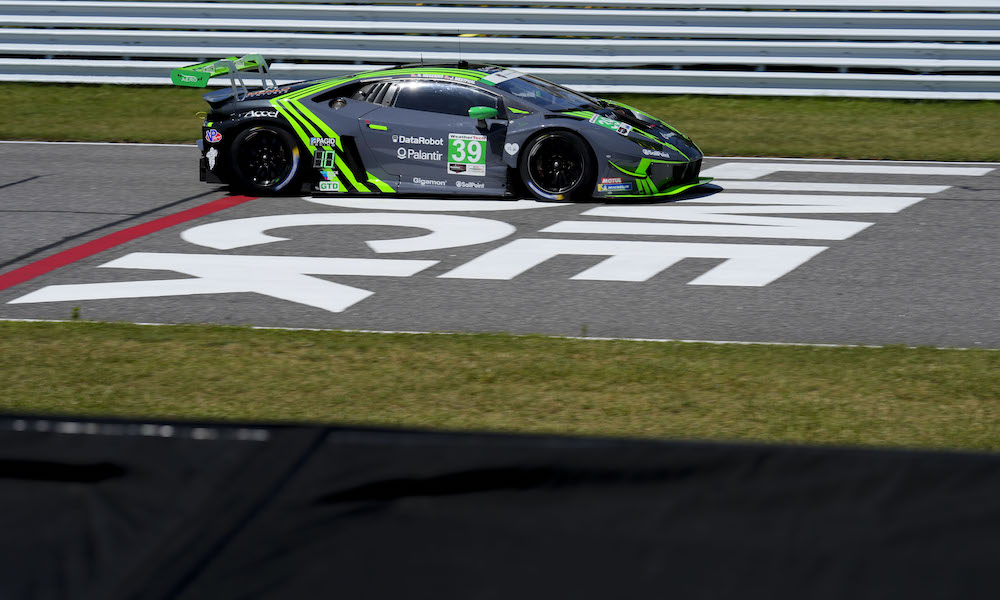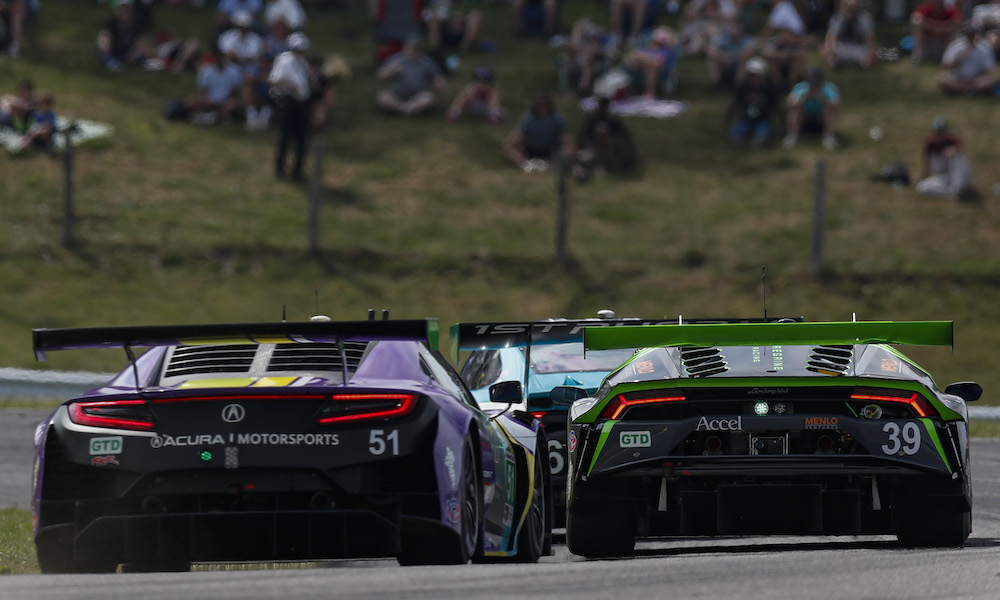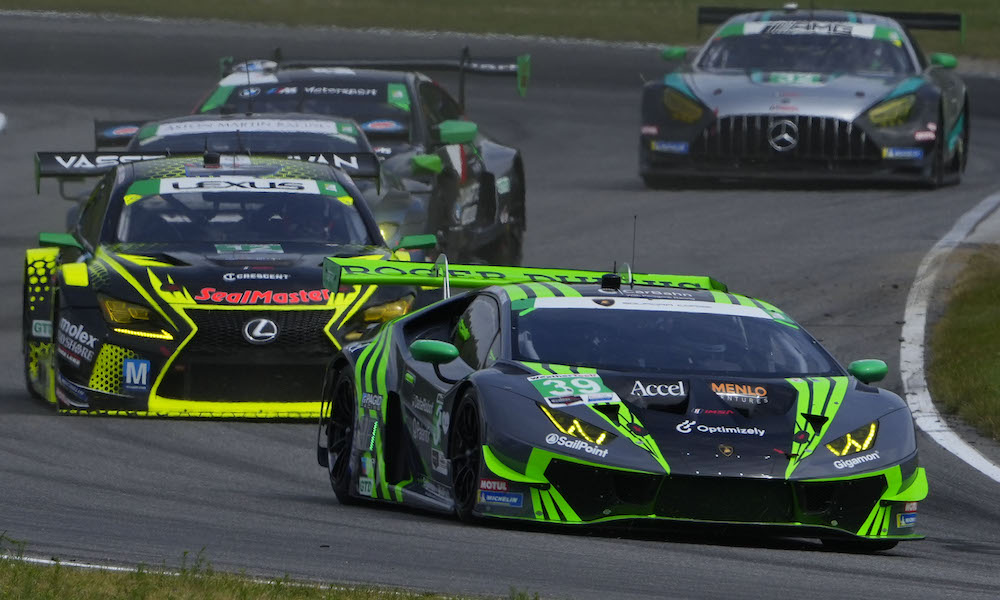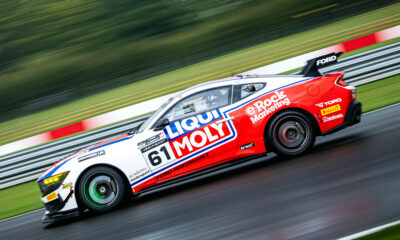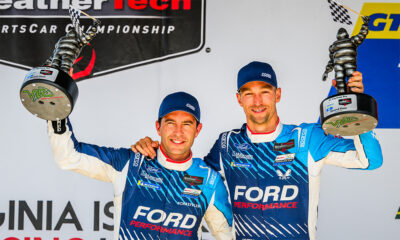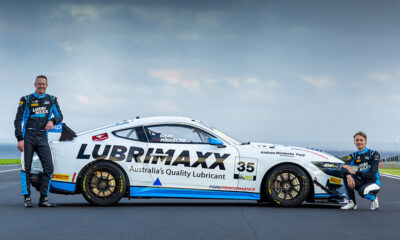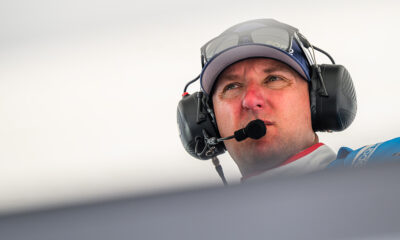Lime Rock is a short, predominantly right-hand track that ends up racing like an oval.
The “Bullring” as we affectionately call it, located in Northwest Connecticut, has a storied history dating back to North America’s racing beginnings.
In more recent years, it’s a track that’s been good to me. I have achieved podiums in both Grand-Am GT and IMSA GS categories (GT3 and GT4 machinery), and top-five finishes when not on the podium in my last five visits.
My teammate Robert has never driven Lime Rock Park, even though this is the track physically closest to his home.
The beginning of our weekend was already a win, because the team behind the black and green Lamborghini had taken delivery of another used chassis, stripped it down, inventoried it and prepped it with series-specific and driver-specific items — all in a short span following our massive crash at the Sahlen’s Six Hours of The Glen just 19 days prior.
I know I speak for Robert as well as myself when I say we are deeply appreciative of not only the crew’s time, energy and sacrifice, but also that of their loved ones at home.
As I set out on track to shake down the “new to us” bull, I also have heaps of new parts to break in. A new clutch, new front brakes, and new electronics that need to be confirmed of their operation. For me, this means leaving pit lane and gingerly adding load/speed to the car, while listening, feeling and smelling for anything unusual.
Next, after communication that all systems seem okay, I set out again with front brakes that are new.
For anyone who has changed brakes themselves, there is a procedure to “bed” in the new pad and disk material. Initially the new items have about 20-40 percent of their “bite” that you expect when you hit the brake pedal.
More complexly, the first time a brake material is exposed to heat can have massive impacts in getting the maximum performance out of them during their lifespan.
At the first consensus, I pit to report what I need from the car to go faster. The Carbahn with Peregrine Racing team makes a setup change and I head back out and sample it again. Knowing the change to the car, I try to exploit the new ability to ask for more speed in particular parts of the track, and we end up a strong P2 at that point in the session.
I opted to get out a little early so Robert could see Lime Rock and get some time. By the end of day one, we had completed two practice sessions and our qualifying, due to a compressed format that shoots us into the race on the second day.
Robert did a great job getting up to speed at a new track and qualified us P2 by 0.006 seconds for the 2-hour and 40-minute race. Needless to say, this bull was FAST.
We progress through the morning and arrive at the race start, roughly 3 p.m. in the Northeast, which brings hot days and high humidity. Robert rolls off from second place and prepares for the green flag.
At the drop of the flagger’s arm, he reacts and nails the throttle, getting a great jump. As the field accelerates, Rob slides to the right slightly to defend the braking in Turn 1 and tries to fight for the lead.
The only trouble here, is that the rules in the IMSA WeatherTech SportsCar championship specify that you must stay within your “column” until the start-finish line on the initial start. So even though we led the first two laps, we were given a drive-through penalty for a “jumped start.”
Despite the setback, Rob hunkered down and set some great laps, passing two cars and saving a little bit of fuel in his 50-plus minute stint.
In a downforce-dependent class, Lime Rock is notoriously difficult to follow around and pass. The other unique challenge to Lime Rock is that due to the short lap (52 seconds), a single pit stop combined with the trip down the pit lane is enough to put you a lap down.
So you must time your stop with the leaders to not fall victim to an unexpected yellow flag that traps you a lap down.
I was told I would need to drive two stints to get us to the end, totaling 1 hour and 50ish minutes, so I prepped the mind and body to handle the task at hand. I opted for the cool shirt. This choice is tricky, because the shirt itself doesn’t breathe as well as my Sparco nomex, but with the liquid moving and the system functioning, it does cool the core down significantly.
Our driver change wasn’t our best, with belts all over the place and trapped beneath me. In order to limit the damage from time lost sitting beyond the fuel and tires, I took off with the cool shirt not plugged in.
Normally, this is something I can do on a straightaway while holding the throttle down and upshifting as the car blasts to redline.
However, this time, the tube that I needed to plug in was tangled, and not somewhere I could find it while on track and keeping pace while pushing to catch cars ahead. I radioed to the team of the struggle and asked if the driver changer could come assist at the next stop, since I was going to need fuel with roughly 65 minutes to go to make it to the checkered.
As the time and laps flew by, I got the radio call to “pit this lap for full service, tires and fuel”.
I hit the pit entry line with the car at 60 km/h [37.2 mph] and cruised to my pit box. The team was swift, and Koji (our driver assist) was able to find and plug in the cool shirt hose, which was a lifesaver as the non-active cool shirt was turning into a hot-liquid-insulated sweater after the first stint. The fuel probe pulled out, I hit the gas, and in a smokey, V10-powered burnout, I left the box with cold tires and a full tank.
The final stint is always an exciting one. Every driver starts to push and take more risks as the checkered flag is in sight.
A message comes through the radio, “We need you to push on cold tires, we have to stay ahead of the No. 16.” To me, this means full risk on cold tires—sliding the car into and out of every corner, multiple saves per turn, balancing the car on a razor’s edge to make sure to not lose a place and gain on the cars ahead during the final pit stop cycle.
At this point, I had enough fuel to make it to the end, so I didn’t need to save anymore and could push at will. It was maximum attack for 60 minutes. This is the stint I love to have—nothing but me and machine for an hour.
As I left pit lane, my front tires had zero bite, and as I bent into Turn 1, the car went straight. I straightened the steering, slowly fed the wheel in again, desperately hoping to get some adhesion from the front tire. A quick lift and reload of the throttle put the rear tires in a small slip, which turned the nose halfway into Turn 1. Only 6.5 more corners to go on cold tires.
I round Turn 7 and come sailing down the front straight to see the No. 16 exiting pit lane. “Phew,” we kept them behind us, now it was full focus on catching the cars ahead.
With 20 minutes in the race to go, I had closed on the cars ahead from 12 seconds down to a gap of 3.5. Then I hear a report that “a car is in the barrier, Turn 7, full course yellow,” through my radio.
The next marshaling stand has two yellow flags in hand, and as I rolled through Turn 7 at half pace I saw the No. 51 Acura of my friend Ryan Eversley buried in the tire wall on the outside. Within one revolution of the track, I saw Ryan out and walking to the medical car meaning he was likely unharmed, which brought me a personal sigh of relief as that corner is well over 100mph for us.
By the time we were ready to go green, we had a five-lap dash to the end. We punched off and accelerated from Turn 6 down into Turn 7, and with the pickup on the hot tires (bits of rubber from the track that stick to a hot tire) I had a less than ideal run through Turn 7. This meant the No. 16 came with a strong attack into Turn 1, in which he was successful in getting around me.
Five corners later, we leave the slow chicane, power up the hill and enter West Bend, a fast right-hand corner that’s a brush of the brake pedal in 4th gear as we turn in. The only caveat to that is that on semi-warm tires and in a bunch of cars with aero loss, you cannot make the corner at that same speed.
The No. 16 over charges the entry and slides wide. I turn in without being able to see the corner ahead, but slide right by him at the apex as he is gathering his car up. The next three laps consisted of second through seventh position running nose to tail.
These circumstances led cars to take big risks, which means I have to defend optimistic moves from both the No. 16 and No. 79 while my own braking is compromised due to traffic ahead.
Multiple taps, hits and rubs on the rear half of my car, sometimes pushing me sideways mid-corner, and we are in the final lap. Less than two car lengths behind the group ahead (P2 through P5) we come down the hill into the final corner. As I crest the hill, I see the leader way off pace at the apex, presumably out of fuel.
In a split second, I plan where I think the No. 57 AMG might be 2 seconds from now. Simultaneously, I see the No. 1 BMW, No. 27 Aston Martin, and No. 32 AMG in front of me go left around the 57.
We are all compromised in rolling speed through the final corner, which is normally the top of 4th gear, so I downshift to 3rd, rotate the car and hit the gas, aiming for the sliver of tarmac between the No. 57 AMG and the apex curb and grass.
With my two right-side wheels in the grass, I slip past the 57 and get a large enough run to pass the No. 32 leaving the final corner, and I close in on the No. 27.
At the stripe, I was up to the 27’s door to take the checkered, and that was good enough for third place. Stealing a podium on a track that is so hard to pass felt like a win.
We grabbed the bull by the horns at the bullring and went for it!



